
Forensic Sciences lab brings closure to families through DNA identification
Thursday, September 22, 2022
Media Contact: Sara Plummer | Communications Coordinator | 918-561-1282 | sara.plummer@okstate.edu
The School of Forensic Sciences’ Human Identity Testing Laboratory at OSU Center for Health Sciences works with national and international coroners and medical examiners to help identify human remains and bring closure to families.
“In the last five years we have had 130 cases submitted to us from across the United States and the world, and we have a 94 percent success rate in establishing the identification of the person,” said Robert Allen, professor of Forensic Sciences and director of the lab. “We try and extract DNA from the remains and then compare it with the DNA of possible surviving family members.”
Allen said the lab is sent samples of everything from bones, blood stains or tissue— sometimes decades old— along with DNA samples from people who are suspected family members of the deceased.
“Sometimes the samples we get are not so good. Over the years we’ve developed methods to identify these types of remains,” he said. “We’re good at getting DNA from some pretty denigrated remains.”
Allen said while some DNA labs can take six months to a year to run tests and report results, the OSU-CHS lab usually has results in two weeks or less.
Phyllis Emery, Forensic Sciences program coordinator, works with the medical examiner and coroner offices as well as potential family members in order to identify remains.
“We get cases where they (the ME or coroner) felt they know who the person might be but want confirmation,” Emery said.
“You don’t have to be a big, expensive operation to give back to your community. And
OSU has supported it. They look at it as fulfilling part of the land grant mission.”
Recently in a case that made national news, the lab identified the 20-year-old skeletal remains of a man found at Nevada’s Lake Mead— not an easy feat as DNA doesn’t preserve well in water.
The Clark County coroner’s office reached out to OSU-CHS’s lab to help them identify the remains of Thomas Erndt who disappeared in August 2002 while swimming and boating on the lake with his family— including his then 10-year-old son and 14-year-old daughter.
“Water and DNA don’t like each other. The coroner’s office said, ‘You have to keep trying.’ They sent us several samples of remains and DNA from the daughter and son and we were able to finally make a match,” Emery said. “I didn’t know this family’s story until later. Now the family has closure.”
While many times those who work at the lab aren’t too familiar with the backgrounds of the cases they are working on, Allen said there are some that stand out.
“Many years ago, we identified the remains of a young man that went climbing at Mt. Whitney in California. We identified him as the son of a woman living in St. Louis, and she was very appreciative,” Allen said. “I came to her and asked if we could keep her son’s femur bone and use it as a teaching tool in our program. She said yes and that she was proud that she could help. It’s now been used to teach 10 generations of Forensic Sciences students.”
Allen, who will retire at the end of 2022, said he was surprised when he looked back at the success of the Human Identity Testing Laboratory.
“When I first curated all this data from the last five years, I would never have dreamed we’d have a 94 percent success rate. We’re just a small laboratory,” he said. “You don’t have to be a big, expensive operation to give back to your community. And OSU has supported it. They look at it as fulfilling part of the land grant mission.”
